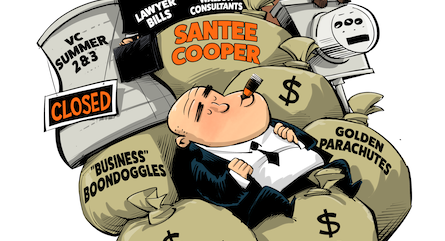Santee Cooper’s “fact check” fallacies
Earlier this summer, Palmetto Promise Institute conducted an in-depth study of aspects of Santee Cooper’s spending. Due to the opaque nature of Santee Cooper’s finances, our research was based on Santee Cooper published sources, legal filings, correspondence to elected officials, legislative hearings, the reporting of The State and The Post & Courier, and even a forthcoming book.* A graphical version of this study, complete with voluminous footnotes, is available on our website.
The purpose of this in-depth exercise was to answer an important question: was V.C. Summer a fluke, or was it part of a trend of poor decisions by Santee Cooper (for which ratepayers alone are paying)? In our research on Santee Cooper’s spending habits, we couldn’t help but conclude that it was the latter.
The highlights of this data were published as an op-ed in the Post & Courier. The research on our site and its op-ed summary highlight the several key spending decisions that Santee Cooper made before, during, and after the V.C. Summer debacle. Our sources were well documented in our extensive endnotes on our website.
Santee Cooper responded to our article, to “set the record straight” in a “Fact Check” about two minor facts in our piece – the preservation costs surrounding two abandoned facilities, the Pee Dee campus and V.C. Summer.
On V.C. Summer, on the issue of how much Santee Cooper was paying annually to preserve the site, our figure of $19 million came from Santee Cooper’s own letter to the Governor in February of 2018, which was reported by The Post & Courier. If they overestimated their costs in that correspondence (they say they have spent “only” $7 million so far), and the numbers have improved to the benefit of customers, we are happy about that. If anything, we have learned here that Santee Cooper’s own projections are not reliable.
On the costs of the defunct Pee Dee plant, we had space in The Post & Courier to mention only the annual maintenance and security costs of the plant ($13 million as projected by Santee Cooper and reflected in media reports and court documents but since revised to $2.5 million).
But there’s more to it. Much more.
The New York Times‘ famous description of itself (“All the news that’s fit to print”) is often more accurately stated, “all the news that fits.” That’s clearly the case here.
We had no words to expend to state the cost of the defunct plant itself.
According to Santee Cooper’s Annual Reports, the most relevant figure here isn’t $13 million, it is $249 million. That’s what the agency spent to acquire a Chinese Power Plant “kit” for that Pee Dee Plant site, that was never placed in service. Who pays that $249 million in sunken costs? Santee Cooper bonding documents say it best: “unrecovered costs associated with Pee Dee Unit 1 will be recovered through customer rates.” (This whole matter is the basis for an ongoing ratepayer class-action lawsuit.)
As a state-owned utility, no investors are standing by to eat the costs of the Pee Dee plant or the VC Summer expansion. Ratepayers are force-fed both.
And as their “Fact Check” response amply demonstrates, defending Santee Cooper finances is like trying to get out of quicksand. Flailing just makes it worse.
*Pollution, Politics and Power: The Struggle for Sustainable Electricity (2019) by Thomas O. McGarity.






